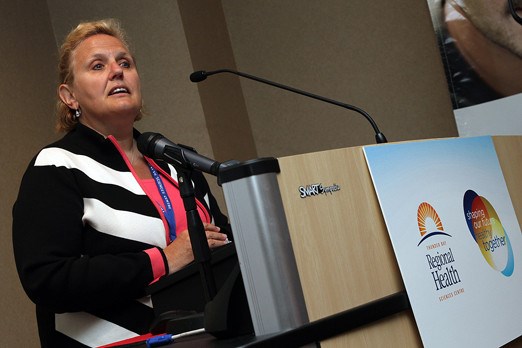Faced with a two per cent decrease in funding, officials at Thunder Bay Regional Health Sciences Centre say they still plan to do more with less.
It’s a wish list that includes the possible addition of cardiac surgery at the hospital, as the institution looks to streamline care and focus more on patient needs rather than trying to be a one-stop solution for every health-care issue.
“It’s all about choices,” said TBRHSC CEO Andree Robichaud on Friday, after unveiling the organization’s four-year strategic plan, placing an emphasis in four key areas: Aboriginal health; chronic disease prevention and management; mental health and addictions and comprehensive clinical services.
“You can’t be everything to everybody. The other thing is those are our priorities. So when we organize the work, we’re going to have to look at realigning our organizational chart, and we’re looking at that for August and September. How do we take those four directions and attribute to our VPs the responsibilities of the sectors?”
The exercise will include taking a hard look at the services the hospital does offer, and potentially ridding themselves of the excess and realigning the funds to the priority areas.
As an example of a potential change comes in the area of prevention, she said.
“We do it for cardio, we do it for renal and we do it for cancer. Maybe we don’t need three different programs doing it, maybe we need one for everybody. That’s an exercise that we’re beginning as a senior management team at the end of June. I think there are efficiencies to be had there. And maybe it’s about reorganizing. My biggest priority is not to close services to the public,” Robichaud said.
The changes won’t lead to fewer employees, she added.
“I don’t see job cuts like I do reassignments,” she said.
Keith Taylor, a volunteer patient and family advisor on the hospital’s board of directors, says he’s happy with the plan, which will take the institution through 2015.
“When you really put pressure on specific items, those are really things that tax the system right now. If you put pressure on that and improve that, it will free up resources right across the board,” Taylor said.
“I don’t think we’ve left any corner untouched.”
Taylor pointed to the ongoing problem of gridlock at the eight-year-old, 375-bed hospital, with as many as 80 alternate-level of care patients taking up beds meant for short-term patients with immediate problems.
“Everybody thinks the solution is to just build a bigger hospital, but one of Andree’s famous sayings really we want to get smaller. We want to work ourselves out of business, and hence the vision is healthy together,” he said.
“If we can get the population healthier, definitely the hospital won’t be overtaxed and you won’t hear that awful word gridlock.”
When it comes to Aboriginal health, the first order of business is establishing better cultural sensitivity and awareness to address specific needs. In chronic disease and prevention management, education and research top the bill. On the mental health and addictions side, compassion and safety are top priorities.
Looking ahead, Robichaud said there are plenty of milestones and guideposts to reach between now and 2015, and she’s confident the hospital can march its way easily past each one.
“We want to see a lot more partnerships. We want to see the patient flow from an acute care facility to community in a way where there are no administrative barriers. It doesn’t matter who manages what. If you’re a patient, you should just flow through the system,” she said.
Sign in or register
- Messages
- Post a Listing
- Your Listings
- Your Profile
- Your Subscriptions
- Your Likes
- Your Business
- Support Local News
- Payment History
Registered Users
Already have an account?
New Users
Create a free account.
